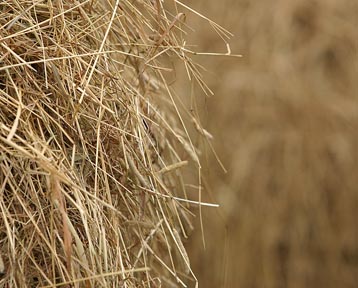Hay Supply Starting to Dwindle
Hay Supply Starting to Dwindle

With hay supplies dwindling, farmers are looking forward to the first flush of spring growth. While there is not a shortage, little hay is expected to be left over after this winter’s feeding is complete.
“December and January were fairly mild with lots of moisture,” said Tom Keene, hay marketing specialist with the University of Kentucky College of Agriculture. “Although it was kind of tough to get hay out because it was so wet, we weren’t feeding a tremendous amount. But in February, it turned cold and we had to start increasing the allotment of hay we were feeding, which has helped dwindle the supply quite a bit.”
In addition, there has been tremendous pressure from southern states for hay because of drought, he said. As a result, a lot of Kentucky hay, even some poorer quality hay that would normally have been available, headed south.
Last year was a good year for hay production, but because of fairly mild winters in recent years, Keene said some producers may have gotten a little too relaxed about the amount of hay they keep on hand. Cold temperatures require more hay for a cow to maintain her body weight, and that’s what happened in February. That along with the pressure from outside markets has really depleted the supply. As a result, Keene said he’s seeing more requests within the state from people looking for hay.
“We will have grass in about the next 30 days, so we are going to be OK,” Keene said. “It’s going to be tight. There will be virtually no carryover, and I think that’s evident when you ride around Kentucky. You usually see rows and rows of big bales by the fence, but if you ride around now I think you will see very little.”
“We’re in a situation this year that the faster we can get on pasture the better off we are,” said Garry Lacefield, UK Extension forage specialist. “The quickest way to stimulate grass-based pastures is with a little nitrogen. It doesn’t take a lot to get us on (pasture) a week to two weeks quicker. As little as 30 pounds of nitrogen per acre can do it. We want to do that about the time that the grass breaks dormancy,and we are getting pretty close to that now.”
For farmers who are running short on hay and finding it hard to get additional hay, Lacefield suggested they select some of their better drained fields and add nitrogen. Because this will be lush grass, he said cattle farmers need to be sure they are feeding the appropriate mineral supplement to avoid grass tetany.
Producers looking to increase hay yield can wait until later the spring and can put up to 100 pounds of nitrogen per acre if striving for top yields. Applying around 60 pounds will give significant increase in first harvest yield and decrease the cost of nitrogen. But Lacefield said they need to consider the cost of the nitrogen and ensure that they are going to utilize all of it and not waste a lot in the grazing system. They should also check phosphorus and potassium levels in their soil as well.
It will be interesting to see what happens this year, Keene said. Acres in hay production could be less this year than in 2006 because increased corn prices are also enticing growers to consider switching some fields from hay to corn, he said.
Keene said a season like this winter shows the importance of research being done to try to lengthen the grazing season, which lowers cost and shortens the amount of stored hay needed. But the need for hay is still going to be there.
“We are going to still have that 60-day to 90-day period where we are going to have to feed hay,” he said. “Our word of caution has always been if you aren’t producing your own hay to go ahead and lock in what you will need. We don’t do a good enough job figuring out what our needs are going to be.”